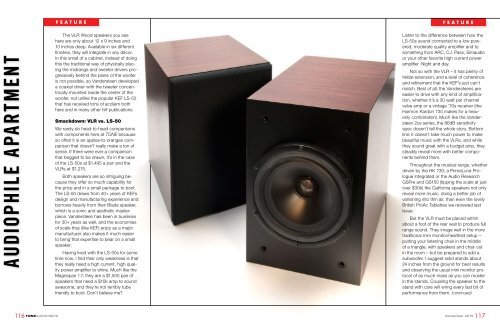You also want an ePaper? Increase the reach of your titles
YUMPU automatically turns print PDFs into web optimized ePapers that Google loves.
FEATURE<br />
FEATURE<br />
AUDIOPHILE APARTMENT<br />
The VLR Wood speakers you see<br />
here are only about 12 x 9 inches and<br />
10 inches deep. Available in six different<br />
finishes, <strong>the</strong>y will integrate in any décor.<br />
In this small of a cabinet, instead of doing<br />
this <strong>the</strong> traditional way of physically placing<br />
<strong>the</strong> midrange and tweeter drivers progressively<br />
behind <strong>the</strong> plane of <strong>the</strong> woofer<br />
is not possible, so Vandersteen developed<br />
a coaxial driver with <strong>the</strong> tweeter concentrically<br />
mounted inside <strong>the</strong> center of <strong>the</strong><br />
woofer, not unlike <strong>the</strong> popular KEF LS-50<br />
that has received tons of acclaim both<br />
here and in many o<strong>the</strong>r hifi publications.<br />
Smackdown: VLR vs. LS-50<br />
We rarely do head-to-head comparisons<br />
with components here at TONE because<br />
so often it is an apples-to-oranges comparison<br />
that doesn’t really make a ton of<br />
sense. If <strong>the</strong>re were ever a comparison<br />
that begged to be drawn, it’s in <strong>the</strong> case<br />
of <strong>the</strong> LS-50s at $1,495 a pair and <strong>the</strong><br />
VLRs at $1,275.<br />
Both speakers are so intriguing because<br />
<strong>the</strong>y offer so much capability for<br />
<strong>the</strong> price and in a small package to boot.<br />
The LS-50 draws from 40+ years of KEFs<br />
design and manufacturing experience and<br />
borrows heavily from <strong>the</strong>ir Blade speaker,<br />
which is a sonic and aes<strong>the</strong>tic masterpiece.<br />
Vandersteen has been in business<br />
for 30+ years as well, and <strong>the</strong> economies<br />
of scale <strong>the</strong>y (like KEF) enjoy as a major<br />
manufacturer also makes it much easier<br />
to bring that expertise to bear on a small<br />
speaker.<br />
Having lived with <strong>the</strong> LS-50s for some<br />
time now, I find <strong>the</strong>ir only weakness is that<br />
<strong>the</strong>y really need a high current, high quality<br />
power amplifier to shine. Much like <strong>the</strong><br />
Magnepan 1.7, <strong>the</strong>y are a $1,500 pair of<br />
speakers that need a $10k amp to sound<br />
awesome, and <strong>the</strong>y’re not terribly tube<br />
friendly to boot. Don’t believe me?<br />
Listen to <strong>the</strong> difference between how <strong>the</strong><br />
LS-50s sound connected to a low powered,<br />
moderate quality amplifier and to<br />
something from ARC, CJ, Pass, Simaudio<br />
or your o<strong>the</strong>r favorite high current power<br />
amplifier. Night and day.<br />
Not so with <strong>the</strong> VLR – it has plenty of<br />
treble extension, and a level of coherence<br />
and refinement that <strong>the</strong> KEF’s just can’t<br />
match. Best of all, <strong>the</strong> Vandersteens are<br />
easier to drive with any kind of amplification,<br />
whe<strong>the</strong>r it’s a 30 watt per channel<br />
valve amp or a vintage ’70s receiver (<strong>the</strong><br />
Harmon Kardon 730 makes for a heavenly<br />
combination). Much like <strong>the</strong> Vandersteen<br />
2ce series, <strong>the</strong> 86dB sensitivity<br />
spec doesn’t tell <strong>the</strong> whole story. Bottom<br />
line: it doesn’t take much power to make<br />
beautiful music with <strong>the</strong> VLRs, and while<br />
<strong>the</strong>y sound great with a budget amp, <strong>the</strong>y<br />
steadily reveal more with better components<br />
behind <strong>the</strong>m.<br />
Throughout <strong>the</strong> musical range, whe<strong>the</strong>r<br />
driven by <strong>the</strong> HK 730, a PrimaLuna Prologue<br />
Integrated or <strong>the</strong> Audio Research<br />
GSPre and GS150 (tipping <strong>the</strong> scale at just<br />
over $30k) <strong>the</strong> California speakers not only<br />
reveal more music, doing a better job of<br />
vanishing into thin air, than even <strong>the</strong> lovely<br />
British ProAc Tablettes we reviewed last<br />
issue.<br />
But <strong>the</strong> VLR must be placed within<br />
about a foot of <strong>the</strong> rear wall to produce full<br />
range sound. They image well in <strong>the</strong> more<br />
traditional mini monitor/nearfield setup –<br />
putting your listening chair in <strong>the</strong> middle<br />
of a triangle, with speakers and chair out<br />
in <strong>the</strong> room – but be prepared to add a<br />
subwoofer. I suggest solid stands about<br />
24 inches from <strong>the</strong> ground for best results<br />
and observing <strong>the</strong> usual mini monitor protocol<br />
of as much mass as you can muster<br />
in <strong>the</strong> stands. Coupling <strong>the</strong> speaker to <strong>the</strong><br />
stand with care will wring every last bit of<br />
performance from <strong>the</strong>m. (continued)<br />
116 TONE AUDIO NO.75<br />
November 2015 117


